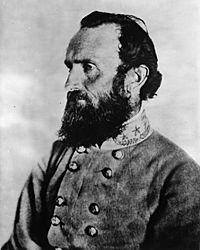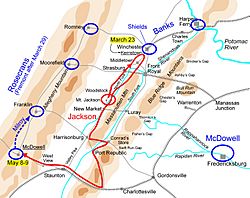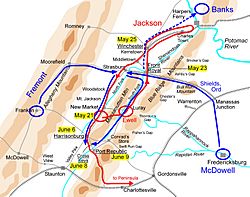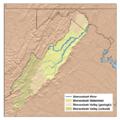Jackson's Valley Campaign facts for kids

The Jackson's Valley Campaign was a series of battles fought in the Shenandoah Valley of Virginia during the American Civil War in the spring of 1862. It was led by a Confederate General named Thomas J. "Stonewall" Jackson. Before this campaign, he wasn't very well known.
Jackson's success in the Valley Campaign made him one of the most famous Southern generals. He marched his army through the Shenandoah Valley for ten weeks. During this time, his army fought in five battles and won four of them. He defeated three different Union armies. His actions kept about 70,000 Union soldiers busy. This was a force four times larger than his own army. These Union soldiers were needed by General George B. McClellan for his Peninsula Campaign. Jackson's amazing Valley Campaign is still studied today. It is seen as a great example of military strategy at the United States Military Academy at West Point.
Contents
Why the Shenandoah Valley Was Important
After winning several battles in the West, the Union Army of the Potomac started a big attack. Their goal was to capture Richmond, the Confederate capital. The Union hoped this attack would quickly end the war.
In Virginia, the Union army controlled the western part of the state. They had armies in Fredericksburg and in the northern part of the Shenandoah Valley.
The Shenandoah Valley was important to both sides. But it was much more important to the Confederacy. Its geography made it a natural path for Confederate armies to attack the North. It also offered a safe place to hide when armies needed to move south. Most importantly, the valley's crops fed the Confederate armies.
Key Battles of the Valley Campaign
First Battle of Kernstown
This battle happened in Frederick County and Winchester, Virginia on March 23, 1862. It was the first battle of Jackson's Valley Campaign. On March 22, Jackson's cavalry commander, Colonel Turner Ashby, had a small fight with Union troops.
On March 23, Jackson sent his cavalry under Ashby to attack the Union position. Colonel Nathan Kimball, the Union commander, gathered his forces on Pritchard Hill. He also set up his artillery there. Jackson placed his artillery west of Pritchard Hill on Sandy Ridge. During the battle, he realized he was fighting a whole division, not a small army. He turned to his helper and said, "We are in for it."
Jackson changed his plan. He put his infantry around his guns on Sandy Ridge. Kimball didn't know his forces were larger than Jackson's. He attacked Sandy Ridge to silence the Confederate cannons. Around four o'clock, Kimball's infantry met Jackson's Stonewall Brigade at the base of Sandy Ridge. The fighting was very heavy. Jackson struggled to hold his position, even sending in more troops.
The fight became a standstill. Neither side could push the other back. Kimball started sending in more Union soldiers. By six o'clock, the Confederates were running out of ammunition. They began to retreat. The retreat turned into a running fight that lasted until dark.
Even though the Confederates lost this battle, it was a big win for them strategically. It stopped the Union from sending soldiers from the Shenandoah Valley to help McClellan's army.
Battle of McDowell
After Kernstown, Jackson's army retreated south to Swift Run Gap. His army joined with Edward Johnson's Army of the Northwest. A division led by Richard S. Ewell also joined them. Jackson now had about 17,000 Confederate soldiers.
Johnson's army was about the size of a brigade. When he joined Jackson, a Union brigade led by General Robert H. Milroy was following his army. Milroy was waiting for another Union brigade under General Robert C. Schenck. Milroy moved west near the village of McDowell.
Jackson, now at Staunton, Virginia, moved his forces west towards Milroy and Schenck's Union brigades. On May 8, Milroy attacked the Confederates on Sitlington’s Hill. The two armies fought for four hours. Finally, Milroy's army was pushed back at nightfall. The Confederates had more casualties. But Milroy and Schenck retreated into western Virginia during the night. This allowed Jackson to focus on the other Union army in the valley. He would keep Union forces busy in the valley for another month.
Battle of Front Royal
The next battle took place on May 23, 1862, at Front Royal, Virginia. Jackson's forces attacked a Union garrison of 1,000 men. This garrison was led by colonel Kenly. The Confederates surprised the pickets and quickly took them over. They pushed the Union force back through the streets of Front Royal. The Union soldiers retreated to Camp Hill, which is now Overlook Park in Winchester.
Kenly's force tried to burn the river bridges as they retreated. But the fires were quickly put out. On Camp Hill, the Union forces tried to hold their ground. But they soon fell back to Guard Hill. They were quickly outflanked by the Confederate force. They then retreated towards Cedarville. Confederate cavalry under Major Flournoy charged the retreating Union forces twice. About 900 Union soldiers surrendered.
First Battle of Winchester
Jackson's win at Front Royal made Union General Nathaniel Banks move his forces. Banks retreated from Strasburg to Winchester. With Jackson now on his right side, Banks was in danger of being cut off from his base at Winchester.
President Lincoln felt Jackson's army in the Shenandoah Valley was a threat to Washington D.C. He ordered General Irvin McDowell's corps to stay at Fredericksburg, Virginia. They were not to join McClellan's Union attack towards Richmond.
When Banks arrived at Winchester, he started setting up his defenses. Jackson's army came from the south. Ewell's army came from the southeast. On May 25, Jackson's forces attacked first, but they were pushed back. Ewell's division attacked Camp Hill. At the same time, Jackson's Louisiana Brigade went around the Union position on Bower's Hill. They then took over the position.
With their sides broken, the Union troops began a messy retreat through Winchester. Even citizens of Winchester fired at the Union soldiers. Banks retreated across the Potomac River back into Maryland. As a result of the battle, Banks lost about 2,000 men. He also lost almost all of his supplies. The Confederates had only about 400 casualties. This was a decisive victory for Jackson's Valley Campaign.
Battle of Cross Keys
Lincoln was now worried that Jackson's Confederate army might attack Washington D.C. if Banks couldn't stop him. On May 24, he told Generals John C. Frémont and Irvin McDowell to send troops to help Banks. This was before Banks was defeated at Winchester. Frémont was ordered to move his forces towards Harrisonburg, Virginia. McDowell was ordered to send 20,000 of his 40,000 troops to help Banks at Winchester.
On June 8, Frémont’s 11,500-man Union army found Ewell's Confederate division at Cross Keys, Virginia. Ewell had been told to stop Frémont from moving towards Port Republic, Virginia. The battle began with a two-hour duel between the Union and Confederate artilleries. A Union flanking maneuver from the left was pushed back by Confederate volley fire. This surprise volley caused 258 Union casualties in less than ten minutes.
Frémont did not realize he was fighting a smaller Confederate force. Under the protection of his artillery, Frémont fell back to the Keezletown Road. The next day, two Confederate brigades kept Frémont busy. The rest of Ewell's Confederates moved towards Port Republic.
Battle of Port Republic
On June 9, 1862, the last of the six battles of Jackson's Valley Campaign was fought at Port Republic, Virginia. Jackson had arrived in the area after dark on June 7. The next day, he learned that Frémont's Union forces had been stopped from joining General James Shields at Cross Keys.
Early on June 9, Jackson's forces used a temporary bridge to cross the South River in Virginia. Union General Erastus B. Tyler placed artillery on a ridge. This covered the front of the Union position. When Jackson arrived, he ordered an attack across a wheat field. He did not take time to organize his forces. He also had not checked to see what Union forces were there or how they were placed.
The Stonewall Brigade led the Confederate charge. As they moved forward, they came under heavy attack from Tyler's artillery. Jackson sent Richard Taylor's Louisiana brigade on a flank attack against the Union artillery. But the Union gunners saw the flank attack coming. They stopped the Confederates with artillery fire.
Jackson knew he had to break through the Union line before Frémont could join Shields. While Jackson was trying to figure out a solution, Ewell's men arrived from Cross Keys. Ewell immediately saw the problem. He attacked the Union left side. This gave the Stonewall Brigade time to get ready again. Confederate artillery batteries opened fire on the Union front. This caused the Union line to break and retreat. This last victory gave Jackson control of the upper and middle Shenandoah Valley.
What Happened After the Campaign
Jackson's Valley Campaign in the spring of 1862 was a huge success. In just 48 days, his roughly 17,000 Confederates marched 646 miles (1,040 km) up and down the Shenandoah Valley. They fought and defeated three different Union armies. These armies had about 52,000 men in total. Jackson kept them from helping McClellan's army on the Virginia Peninsula.
The campaign cost the Union 5,735 casualties. The Confederates lost about 2,441 casualties. They captured so many supplies from Banks' army that Confederate soldiers started calling the Union general "Commissary Banks."
Images for kids
-
Maj. Gen. Stonewall Jackson, Commanding -
Maj. Gen. Richard S. Ewell -
Col. Turner Ashby Jr. -
Maj. Gen. Nathaniel P. Banks, Department of the Shenandoah -
Maj. Gen. John C. Frémont, Mountain Department -
Maj. Gen. Irvin McDowell, Department of the Rappahannock -
Brig. Gen. Robert C. Schenck -
Brig. Gen. John Reese Kenly -
Brig. Gen. Erastus B. Tyler -
Col. Nathan Kimball
See also
 In Spanish: Campaña de Jackson's Valley para niños
In Spanish: Campaña de Jackson's Valley para niños


























